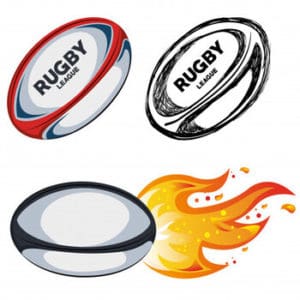Rugby sevens, a faster and more dynamic variant of traditional 15-a-side rugby, features seven players on each team. Each position has a specific role, requiring unique skills and attributes to succeed on the field. Below, we’ll explore each position in detail, discussing their roles, strengths, playing style, and notable players who have excelled in these positions.

1. Prop
In rugby sevens, the prop’s role is versatile, combining physicality with agility. Unlike in 15s, sevens props are not limited to scrummaging and mauling; they must also contribute significantly in open play.
Role:
- Provide strength in scrums and rucks.
- Act as a ball carrier, breaking through defensive lines.
- Offer support to teammates in both attack and defense.
Strengths:
- Physical power to dominate contact situations.
- Good ball-handling skills for offloads and passes.
- Endurance to keep up with the fast pace of sevens.
Famous Players:
- Tim Mikkelson (New Zealand): Known for his exceptional work rate and ability to cover large areas of the field.
- Andrew Amonde (Kenya): A powerful leader who excels in both attack and defense.
2. Hooker
The hooker in sevens has a dynamic role, contributing in scrums, lineouts, and open play. They are often smaller and more agile than their 15-a-side counterparts.
Role:
- Throw the ball in during lineouts.
- Compete for possession in scrums.
- Support play by linking forwards and backs.
Strengths:
- Accurate lineout throwing.
- High work rate around the field.
- Strong tackling ability to disrupt opposition attacks.
Famous Players:
- Sam Dickson (New Zealand): Renowned for his physicality and lineout prowess.
- Paulo Duarte (Portugal): A tireless player with excellent technical skills.
3. Scrum-Half
The scrum-half in rugby sevens is the key playmaker, acting as the link between the forwards and backs. They are often one of the most skillful players on the team.
Role:
- Distribute the ball quickly from scrums, rucks, and lineouts.
- Direct the team’s attacking play.
- Provide defensive cover across the field.
Strengths:
- Quick decision-making and excellent passing skills.
- Tactical awareness to exploit gaps in the opposition defense.
- Strong defensive abilities to stop fast attackers.
Famous Players:
- Tom Mitchell (England): Known for his leadership and playmaking abilities.
- Jerry Tuwai (Fiji): A creative genius with exceptional vision and agility.
4. Fly-Half
The fly-half is another crucial playmaking position, responsible for orchestrating attacks and making strategic decisions under pressure.
Role:
- Direct the team’s attacking structure.
- Kick for territory or points when necessary.
- Act as a secondary distributor alongside the scrum-half.
Strengths:
- Excellent kicking and passing abilities.
- Tactical intelligence to read the game and adjust strategies.
- Composure under pressure, especially in critical moments.
Famous Players:
- Cecil Afrika (South Africa): A gifted playmaker with a knack for breaking defenses.
- Nathan Hirayama (Canada): Renowned for his kicking accuracy and game management.
5. Centre
The centre in sevens is a powerful runner, tasked with breaking the defensive line and creating opportunities for their teammates.
Role:
- Carry the ball and exploit gaps in the opposition defense.
- Support wingers and link up with other backs.
- Contribute defensively with solid tackling.
Strengths:
- Speed and agility to evade defenders.
- Strong ball-carrying ability.
- Defensive awareness to shut down opposition attacks.
Famous Players:
- Collins Injera (Kenya): One of the highest try-scorers in sevens history, known for his speed and finishing ability.
- Werner Kok (South Africa): A tenacious defender and powerful runner.
6. Wing
Wingers in rugby sevens are the primary try-scorers, utilizing their speed and agility to outpace opponents and finish scoring opportunities.
Role:
- Exploit space on the flanks and score tries.
- Provide defensive cover on the edges of the field.
- Support counter-attacks with blistering runs.
Strengths:
- Exceptional speed to beat defenders.
- Strong finishing ability under pressure.
- Agility and balance to stay in play along the touchline.
Famous Players:
- Dan Norton (England): One of the fastest players in sevens history and a prolific try-scorer.
- Carlin Isles (USA): Dubbed the “fastest man in rugby,” known for his incredible pace.
7. Sweeper (Fullback)
The sweeper, often considered the last line of defense, plays a crucial role in both attack and defense. They must be versatile and composed under pressure.
Role:
- Cover defensive gaps and make crucial tackles.
- Launch counter-attacks from deep positions.
- Support the fly-half and centre in creating attacking opportunities.
Strengths:
- Strong positional awareness and defensive skills.
- Ability to read the game and anticipate opposition moves.
- Excellent kicking and running ability.
Famous Players:
- Perry Baker (USA): A two-time World Rugby Sevens Player of the Year, known for his pace and finishing.
- Tim Agaba (South Africa): A reliable defender and powerful ball carrier.
Conclusion
Each position in rugby sevens demands a unique set of skills and attributes, contributing to the team’s overall success. From the physicality of the prop to the speed of the winger, every player plays a vital role in the fast-paced, high-stakes environment of sevens rugby. By understanding these roles, fans can better appreciate the intricacies and excitement of this dynamic sport.
